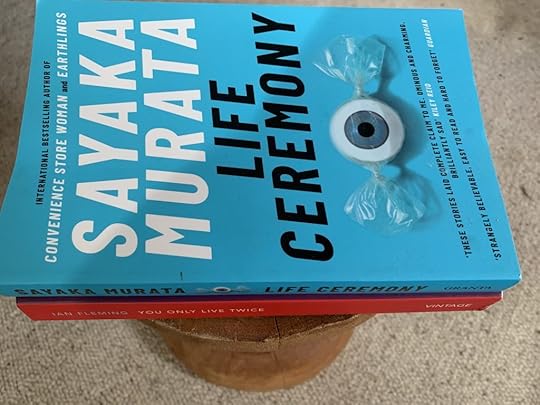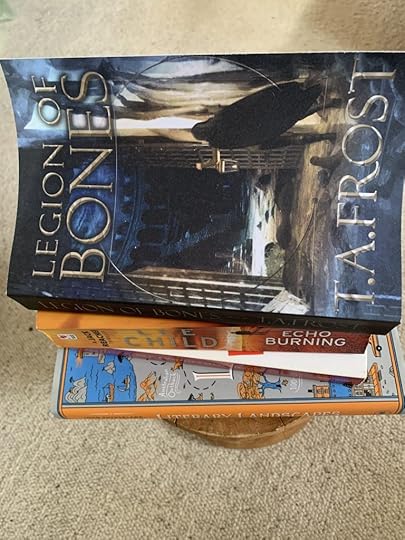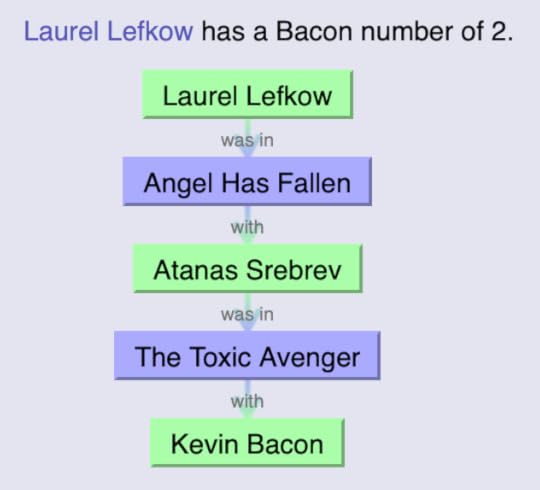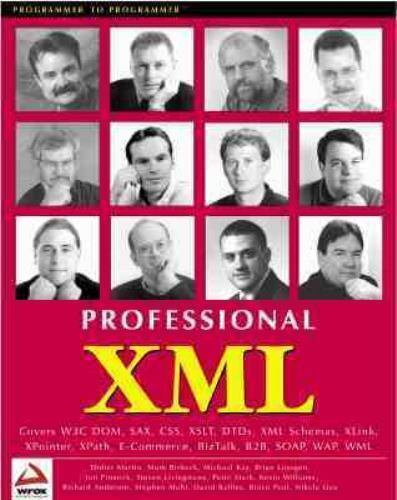Jonathan Pinnock's Blog
November 4, 2025
What I Read in May

Still playing catch-up, so there might be a sudden burst of posts to get us back in sync. Or I may just forget about this place again – feel free to take bets on what’s going to happen. Faites vos jeux, mes amis… (and I do love the way that the WordPress editor tries to substitute ‘cos’ for ‘vos’, as if I’m writing about lettuces). Only two books this time, either way, because the second half of the month was taken up with the book that will dominate proceedings for June, July and August.
You Only Live Twice by Ian Fleming. In which our author goes full-on romantic. There is remarkably little action here, considering that this is supposed to be a spy novel. Roughly three-quarters of the book is essentially the paperback equivalent of a training montage, intercut with two burgeoning love stories: the one between Bond and – God help me, this really is the same she’s been given – Kissy Suzuki, and the more interesting one between Ian Fleming and Japan. The action bit comes right at the end and is almost perfunctory in its execution, although Bond does come off slightly the worse for wear as a result, suffering the memory loss that will lead to the chaotic opening of the next and final book in the series, The Man With the Golden Gun.
Life Ceremony by Sayaka Murata. So, then. We all loved Convenience Store Woman for its difficult, neurodivergent heroine, and then we went out and bought Earthlings and none of us has been quite the same since. Life Ceremony is a collection of short stories that verge more into Earthlings territory than Convenience Store Woman, and I wonder if the level of weirdness gets just a tad wearing after a while. I’ll certainly keep reading her books, though, because she’s such an unusual voice.
The post What I Read in May appeared first on Jonathan Pinnock - Writer of Stuff.
September 9, 2025
What I Read in April

Time for another of these catch-up posts, with a real mixed bag of treats this time.
Some Hope by Edward St Aubyn. Book number three in the Patrick Melrose sequence, and a bit of an odd one, in that Melrose himself takes very little part in the proceedings, leaving the floor vacant for a whole cast of ghastly rich people attending a dreadful house party. Still, according to Zadie Smith on the front cover, the book has the wit of Wilde, the lightness of Wodehouse and the waspishness of Waugh, so it must be OK, right? Well, at this point I refer you to the book’s title. The question now is: do I give in to my completist urge and still get books four and five? God knows.
HHhH by Laurent Binet. I remember this being very big a few years back and now I know why. Extraordinary piece of storytelling. Is it non-fiction or a novel? Does it matter? I’m very keen to read more of his stuff now.
The Enemy Within by Adam MacQueen. I read the first book in this series, Beneath the Streets, a while back (might have been a freebie from the publisher) and really enjoyed the clever way that MacQueen inserted his protagonist into recent historical events – specifically the Wilson years and the Thorpe scandal. This continues in the same vein, this time against the backdrop of the Thatcher years, and it’s almost as entertaining, even if the events are somewhat grimmer.
The Decagon House Murders by Yukito Ayatsuji. Another slice of Japanese crime fiction, from the author of The Mill House Murders. This time we have a slightly warped version of And Then There Were None. It’s nice to see that there are writers still following in the Christie tradition.
The post What I Read in April appeared first on Jonathan Pinnock - Writer of Stuff.
September 3, 2025
What I Read in March

And here we go again. There is very little to report on the writing front right now (although there is definitely some of that going on from time to time) and I am six months late in reporting on my reading. But let’s pretend that no-one’s noticed (which may in fact be true, given the number of readers this blog has) and carry on as if everything is normal, OK?
So this is what I read in March 2025.
Literary Landscapes edited by John Sutherland. I got given this coffee table book a few Christmases back and it’s a lot of fun. Basically, it’s a collection of illustrated essays about the real places that have informed recent and not-so-recent literary classics, such as Elena Ferrante’s Naples, that kind of thing. If you’re a writer and you have a coffee table handy, I would definitely recommend it.
On Her Majesty’s Secret Service by Ian Fleming. A few years ago I set out on a quest for no good reason to read all the Bond novels in order. I’d somehow got out of the habit, to the extent that if I wanted to keep them all in the same edition (and of course I did – what kind of a monster do you think I am?) I found that I had to buy this one secondhand. This is, of course, [spoiler alert] The One In Which She Dies At The End, and there’s a definite sense of Fleming stretching himself emotionally a bit here, and the results are better than most of the rest of the series. Stick around for next month, when we look at You Only Live Twice, which is actually very odd indeed.
Echo Burning by Lee Child. This was another series that I’d started from scratch and then drifted away from. This is the fifth Jack Reacher novel and it wisely eschews the downright weirdness of The Visitor for a more conventional smalltown corruption plot. There is absolutely no messing about with Child’s prose, which delivers exactly what you want at the pace you want it.
Legion of Bones by T.A.Frost. This is the final novel in what you might call “the serious trilogy” by Toby Frost, who is much better known for the extremely funny Space Captain Smith books. If renaissance period zombies are your thing – and, honestly, why shouldn’t they be? – look no further. In my opinion, it’s a terrible reflection on the state of the publishing industry that Toby ended up self-publishing these books, because they are absolutely excellent. They are witty (of course), fast-paced and genuinely exciting, with a terrifically feisty heroine in the shape of Giulia Degarno.
The post What I Read in March appeared first on Jonathan Pinnock - Writer of Stuff.
April 14, 2025
What I Read in February
In the absence of any exciting original blog content, we bring you yet another report on what I read, this time in February 2025. Bit of an eclectic bunch this time, to say the least.
The Avengers from the Penguin Classics Marvel Collection. I’d put this on my Christmas list mainly because I absolutely loved the idea of Penguin Classics doing a Marvel collection. During lockdown, we watched every single bloody MCU film in order, so I was keen to have a proper look at the source material, having somehow missed out on that sort of thing when I was a kid. And it was a lot of fun, even if some of it was – inevitably – hilariously dated.
Octavia, Daughter of God – The Story of a Female Messiah and her Followers by Jane Shaw. A few years back I was amazed to discover that the town that I’d grown up in, Bedford, had been host to a full-on bonkers religious cult. (If you’re not familiar with the Panacea Society, I strongly recommend taking a look at this excellent documentary, by the way.) This book is a comprehensive history of the whole shebang, written by a proper religious academic. It’s very respectfully done – as is probably the only way to deal with something like this – although you can definitely detect an authorial raised eyebrow at times. An absolutely fascinating read.
Six Stories by Stefan Zweig. I’d wanted to read some Zweig ever since I saw The Grand Budapest Hotel, so when I saw this on the shelves in the secondhand book shop at Hestercombe Gardens, I snapped it up. I’m very pleased I did, because they are absolutely excellent. I was particularly taken with the very first story in the book, The Invisible Collection, which is almost Borgesian – apart from, ironically, it being a story about blindness that probably only a sighted author would think of writing.
Origin by Dan Brown. From the sublime to the utterly preposterous. The recent publicity surrounding the publication of a new Dan Brown novel (called, God help me, The Secret of Secrets) reminded me that there was one I hadn’t got round to reading. I guess Dan Brown is the nearest thing I get to a guilty pleasure (something I don’t really believe in – a thing’s either a pleasure or it isn’t). The combination of action and wild conspiracies can be quite intoxicating, even if the writing is… not great. However, in Origin, the action peters out literally 150 pages before the end of the book, and all we’re left with is a massive swathe of explanation of an underlying conceit that is depressingly underwhelming. Ah well, that’ll teach me.
Unnatural Death by Dorothy L. Sayers. I started reading the Lord Peter Wimsey series from the start a while back and found the first two a little disappointing. However, this book was in a different league – a genuine page-turning mystery, along with some pithy social comment (including – I should warn you – some spectacular and unvarnished racism from one or two of the characters). I’ll definitely be reading more of these.
The post What I Read in February appeared first on Jonathan Pinnock - Writer of Stuff.
March 27, 2025
What I Read in January
And the answer is: not a lot. Or rather, I didn’t actually finish many books in January, because I was still working my way through the longest one when the end of the month came, so you’ll have to wait until the February post to find out what that was all about. So here we go…
Humble Pi by Matt Parker. My daughter bought me this for Christmas and then immediately regretted it, assuming that I’d already read it. However, it turned out that I hadn’t, although I’d frequently noticed it appearing alongside The Truth About Archie and Pie in the Amazon chart for Kindle Mathematical Recreation and Games (I love Amazon categories). Parker (also known as “The Stand-Up Maths Guy”) is a very entertaining writer, and this was a lot of fun to read, despite my feeling more than a little jealous of someone who was clearly building a much more successful career out of combining humour and mathematics.
The Big Short by Michael Lewis. I read Liars’ Poker years ago and thoroughly enjoyed it, so I’ve always meant to read more of Lewis’s stuff and when I saw this in the Hestercombe Gardens secondhand book shop, I snapped it up. It’s an excellent account of the 2008 financial crash and the insanity that led up to it. He’s particularly good at picking apart and explaining the crazy financial instruments that were used to build the house of cards, which makes it all the more inexplicable that in his latest book, he appears to have completely misread Sam Bankman-Fried and the wacky world of crypto.
And that’s it. Plenty more next time, however.
The post What I Read in January appeared first on Jonathan Pinnock - Writer of Stuff.
February 20, 2025
What I Read in November and December
Well. This didn’t really go according to plan. As things turned out, I read five books in November but I only managed to complete one in December – hence the decision to combine the two months. And I’m also late posting about them. Not good.
Anyway, here goes…
[image error]Wodehouse at the Wicket by PG Wodehouse. Bit of an odd one, this. As you can probably guess, it’s an anthology of Wodehouse’s writings on cricket, which I picked up at Hestercombe Gardens’ excellent secondhand book shop (which I may have mentioned before). To be honest, it’s a bit sloppy. There’s a rather unnecessarily long introduction, followed by a bunch of somewhat below par pieces without any indication of where they were originally published (unless I missed this). So much as I love Wodehouse’s work (“The Code of the Woosters” is one of the greatest books ever written in the English language), I was just a tad disappointed by this one.
Nomad by Alan Partridge. OK, it’s actually by Rob and Neil Gibbons and Steve Coogan, but we can pretend, right? This is a lot funnier than it has every right to be, and I’d love to know more about how the Gibbons brothers came to be involved – almost twenty years after he first appeared – with the Partridge project, because they seem to have got the character spot on. I’d never really bothered with any of these, but I think I’ll have to get the other books now.
Serious Concerns by Wendy Cope. I bought this because I loved Making Cocoa for Kingsley Amis and it’s the one with the Orange poem in it, which is wonderful. The other poems are pretty good, too, and I wish there were more poets with her sense of humour that I could read and enjoy. But we wouldn’t want too much of that sort of thing to get published by the likes of Faber, would we?
Open Heart University by Spike Milligan. I think this was another Hestercombe Gardens purchase. I used to read Milligan obsessively, but for some reason I’ve never had a copy of this poetry collection until now. It’s a little bit hit and miss, to be honest, and oddly a lot more serious than, say, Wendy Cope’s work. It completes the set, though.
The Guest List by Lucy Foley. This follows roughly the same formula as her previous book, The Hunting Party – basically a bunch of horrible people spend a weekend together at an isolated place and Bad Things Happen. Great fun, and I’ll certainly read more of her stuff.
Absolute Beginners by Colin MacInnes. I bought this one after hearing it featured on the Backlisted podcast, and after the slightly disappointing first book in the trilogy, City of Spades, I’m pleased to report that this was every bit as good as the Backlisted team made it out to be. I was particularly pleased with the ending, because this kind of book often runs out of steam by that point, but this was rather unexpected and lovely. I have – for completeness’ sake – got the final book in the trilogy, Mr Love and Justice, on my shelf, although – also thanks to Backlisted – I have lowered my expectations for that one. We’ll see.
The post What I Read in November and December appeared first on Jonathan Pinnock - Writer of Stuff.
November 26, 2024
What I Read in October
Whoops. Bit late with this one. Also, I’m still only managing four books a month. Could do better. Anyway, here we go.
City of Spades by Colin MacInnes. I bought this mainly because of the episode of the excellent Backlisted podcast on MacInnes’s Absolute Beginners, and because that book is nominally part of a trilogy, I thought I’d read them in order, because that’s the way my mind works. So City of Spades is the very first in the trilogy and I’m sort of assuming it’s basically MacInnes clearing his throat, preparing for his masterpiece. It’s certainly an interesting read, giving a fascinating insight into the black subculture of 50s London. However, it’s one of those novels that consists of a series of episodes that doesn’t really lead anywhere satisfactory. It hasn’t put me off reading Absolute Beginners, however, and I’ll probably be diving into that in December.
Lost for Words by Edward St Aubyn. Ah. Well, this was another of my Hestercombe Gardens secondhand bookshop acquisitions. I’ve read a couple of St Aubyn’s Patrick Melrose novels – enjoyed Bad News, not quite sure about Never Mind – but this was a different kind of beast altogether. It’s a self-consciously comic novel based around a farcical literary award and, my God, it tries so very hard to be funny.
However, this isn’t always successful, basically owing to misunderstandings of the form. For example, the book contains extracts of the various terrible books that are under consideration, and one is quite a neat parody of an Irvine Welsh novel. However, a couple of chapters later a character refers to the novel as being like a poor imitation of Irvine Welsh, at which point the joke vanishes. There was no need to do this. There’s also a weird subplot potentially leading to a very dark grand guignol ending, which I could totally imagine the St Aubyn of Patrick Melrose really going for, but for some reason he bottles it.
This book won the 2014 P.G.Wodehouse Prize. Go figure.
“You Are Not Expected to Understand This” – How 26 lines of Code Changed the World edited by Tori Bosch. The Facebook algorithm threw this one at me and I couldn’t resist: twenty-six essays on seminal examples of computer code that changed the world. In the end it was a bit of a mixed bag of some really interesting stuff that was new to me, some stuff that I’d come across elsewhere, some stuff that wasn’t actually that interesting at all and some stuff which shouldn’t have shown the light of day at all, such as the admiring piece on the blockchain algorithm. I mean, really.
An Uncommon Atlas: 50 New Views of Our Physical, Cultural and Political World by Alastair Bonnett. This looks like it was bought for me a Christmas or two ago, but I honestly can’t remember. I’ve been a fan of Bonnett’s work since I read Off the Map: Lost Spaces, Invisible Cities, Forgotten Islands, Feral Places and What They Tell Us About the World and I found this a fascinating read as well, even though it was more of a coffee table book than Off the Map. I’m always drawn to unusual maps and unusual ways of visualising data and the combination presented by this book was irresistible.
The post What I Read in October appeared first on Jonathan Pinnock - Writer of Stuff.
October 15, 2024
What I Read in September
Haven’t done one of these for quite some time. Not sure what, but I temporarily got out of the habit of reading regularly, which is of course a VERY BAD THING for a writer. I’m now making a concerted effort to get back into the habit, and maybe doing this will help me to keep focus.
So here we go.
Tomorrow and Tomorrow and Tomorrow by Gabrielle Zevin. This was every bit as good as everyone said it was. It’s a not quite love story set in the world of gaming software development, which is oddly refreshing: yeah, geeks have feelings, too. I know very little about gaming – mainly because I know that if I were to ever allow myself to get sucked into it, you’d never see me again – but the software development aspects of the plot rang very true, and the characters were all too believable. A great book to get completely absorbed in.
White Spines: Confessions of a Book Collector by Nicholas Royle. I’ve been meaning to get this ever since it came out. It’s the story of the author’s obsession with collecting old-school Picador paperbacks, amongst other things. The first thing to say about it is that the book itself is a loving recreation of the Picador style, even down to the typeface used on the cover. That alone sold it to me, because I also used to be quite obsessed with that Picador look, to the extent that I would buy books purely based on the fact that they were published by the imprint. But what I really enjoyed was the chance to spend a few hours inside the head of someone really interesting, which I guess is what successful memoir writing is all about. This is a book where you come for the account of collecting mania but stay for the odd unexpected byways that Royle’s narrative takes you. Highly recommended.
Shadow Lines: Searching for the Book Beyond the Shelf by Nicholas Royle. Or to put it another way, White Spines 2. This delves further into the world of secondhand books, seeking out odd ‘inclusions’ (improvised bookmarks) and annotations, as well as an entire chapter on the unexpected back story to the illustrations in Rev W Awdry’s Thomas the Tank Engine books. Even more so than White Spines, this is one of those books where you can never be sure where the author is going next, and is all the better for it. Also highly recommended, and I’m very much looking forward to the third book in the series, whenever Royle gets round to writing it.
Penguins Stopped Play: Eleven Village Cricketers Take on the World by Harry Thompson. Taking a leaf out of Nicholas Royle’s book, I bought this at the excellent secondhand book shop at Hestercombe Gardens (well worth a visit, by the way). I really wanted to love it, but I came away just slightly disappointed. The problem with this sort of bloke-lit pointless quest book (and they are always written by blokes, because women have much more sensible things to do with their time) is that they can easily run out of steam halfway through, especially if there’s a rotating cast of excessively quirky characters like there were in this one. Also, given the descriptions of several of the characters, I began to wonder how some of it had got past the lawyers, which in turn led me to wonder how much of it was real, which in turn undermined my belief in the validity of the quest.
One thing I did find fascinating was the extent to which some of the gags seemed a bit off – even for a book that was written in 2005. On page 138, for example, there’s a reference to ‘an elderly Yemeni lady in a chador, whose letterbox eyes burned into mine for several hours.’ I’m now wondering, of course, if another writer who got into trouble for the same phrase a few years later might have nicked it from Thompson. After all, it’s not inconceivable that Boris Johnson might have read this one.
The post What I Read in September appeared first on Jonathan Pinnock - Writer of Stuff.
August 12, 2024
Bacon Numbers and So On
I’m a big fan of random connections, so you will not be surprised to learn that one of my great unfulfilled ambitions is to have a Bacon number. You know, the number of links connecting you to the actor Kevin Bacon, based on who he has co-starred with over his career. I’ll state right from the off that this ambition is very likely to remain unfulfilled, because for one thing I’ve left it a bit late to make the attempt. More importantly, I am not an actor.
That said, the most obscure actor listed on IMDB – the late, great – has a Bacon number of 3, so maybe there’s hope after all. Ms Sellors, famously, is only listed for a single role – “Woman Who Urinates on Herself (uncredited)” – in 1984’s Threads. I like to think that, subsequent to her appearance in Threads, she was approached by a string of Hollywood producers and turned every single one of them down in order to keep her CV pure.

You can easily find out any given actor’s Bacon number by using the excellent Oracle of Bacon website, and of course this does lead into temptation. Because every so often, I convince myself that, like Anne Sellors, I too have a Bacon number of 3. My argument is based on the fact that Laurel Lefkow, who read my story “The Amazing Arnolfini and His Wife” on BBC Radio 4, has an impressively low Bacon number of 2. You can tell me that just being the writer of a radio short story doesn’t count, but I may not choose to listen to you.

In any case, just having a Bacon number is a bit unambitious; the really cool kids have an Erdős – Bacon number. Paul Erdős was a mathematician who co-authored a daft number of papers in all branches of the subject and hence occupies the role of Kevin Bacon in the world of academic mathematics. Almost every mathematician worth their salt – along with several in related disciplines – has an Erdős number. However, having an Erdős – Bacon number is a little rarer. Natalie Portman has one (7), as does Colin Firth (6), along with the likes of Stephen Hawking (6) and Carl Sagan (also 6), so the bar to entry is quite high.
Now it happens that I do – sort of – have some skin in this game. As described elsewhere on this website, I have written two books that have been cited in learned academic papers, Professional DCOM Application Development and Mrs Darcy versus the Aliens. And yes, these do indeed show up on Google Scholar. Now I don’t know about you, but this makes me think that if a book can be cited in an academic paper, then books and papers are – sort of – equivalent. Which means that if I happened to have collaborated on a book with someone who has an Erdős number of n, I would have an Erdős number of n + 1, right?
Right?
As it happens, I can easily put my finger on someone I know who has an Erdős number (4, as it happens): Kevlin Henney. As well as being a renowned software expert, Kevlin is a writer of short fiction who has been in several anthologies that I’ve turned up in as well. Would that count?
I think that’s a bit flaky, to be honest. To suddenly flip from academe to flash fiction is a bit of a stretch. No, I think I need to choose a more technical book for my prospective co-author. This is easier than it might initially seem, because I’ve actually written odd chapters for a dozen software books. The most promising one appears to be Professional XML (Wrox, 2000).

Like the Oracle of Bacon, there is of course a site – CSAuthors – that enables you to find out any given person’s Erdős number. Whisper it quietly, but it’s actually a whole load better than the Kevin Bacon one, too. Not only that, but it also gives you your target’s Djikstra number, which is a kind of computer science version of their Erdős number, except that it gives you your collaborative distance from Edsger Djikstra, if that happens to float your boat.
Using this, I can establish that of my eleven co-authors, four potentially have Erdős numbers, although there is no way of immediately telling that they are indeed the same people and not just two different people with the same name. Indeed, I am immediately minded to discard Didier Martin (Erdős 4) because I can’t tie the one in Professional XML to the one on CSAuthors at all, and there seem to be more than one Didier Martin working in IT. Stephen Mohr (4) and Peter Stark (5) look more promising, but I still can’t make a definite connection.
However, Mark Birbeck (4) looks a lot more promising, as his papers listed on CSAuthors are very XML adjacent. So I’m going to claim that he is very much my co-author on Professional XML, meaning that I can – sort of – claim an Erdős number of 5, and hence an Erdős – Bacon number of 8. Sadly, even if this were to be regarded as remotely legit, it would still be one higher than the scores of every single individual mentioned on the Erdős – Bacon Wikipedia page.
Moving on from acting and academe, it struck me that no-one as far as I know has yet attempted to put together any kind of collaboration map for podcasts. Given the complete lack of official documentation, it would be a horrendous task to contemplate, although I guess it’s not beyond the bounds of possibility to consider putting together some kind of bot that would trawl the various pod hosting sites, digging out guest lists from the show notes. I’m not sure who would fulfil the Bacon / Erdős / Djikstra role here – probably some ghastly right-wing American – but we could sort that out later.
More importantly, I would immediately find myself a mere two links away from – for example – Robert Fripp and Robyn Hitchcock (via Andrew Male, my guest in episode 20 of It’s Lit But Is It Funny?, who also co-hosts the Mojo Record Club podcast) and Stephen Fry (via Andy Miller, my guest in episode 9 of ILBIIF, who also co-hosts Backlisted). I quite like that idea. Someone do this, please.
The post Bacon Numbers and So On appeared first on Jonathan Pinnock - Writer of Stuff.
August 3, 2024
The WordPress White Screen of Death
I’m guessing that most of you out there are familiar with the Windows Blue Screen of Death (or BSOD). However, you may be less familiar with the WordPress White Screen of Death (or WSOD), although if you’ve visited this site recently, it’s entirely possible you may have experienced one in the wild. This place has been having some issues – some that I’ve only just become aware of.
A WSOD is exactly what it sounds like – even more so than a BSOD – in that it’s a completely blank page with nothing remotely helpful on it. I first encountered one on the Burnham Book Festival site a month or so ago, when a user reported being unable to use the online shop. I did what any developer would do and googled for an answer and basically what turned up was that there were several reasons for this happening – the most likely ones being a rogue plugin or insufficient memory.
I didn’t fancy going through the process of deactivating all the plugins and then turning them back on, one by one – especially as the problem was intermittent. So I went straight for the insufficient memory explanation. And it did look plausible, because when I added the following lines to my wp-config.php to get some debug output:
define ('WP_DEBUG', true);define ('WP_DEBUG_LOG', true);and looked at the debug.log file generated in my wp-content folder, it reported that at some point – which varied from one instance to the next – it was trying to get more memory than a pre-defined limit. This limit looked suspiciously like 128Mb.
So I added the requisite line below this to double the memory to 256Mb:
define('WP_MEMORY_LIMIT', '256M')However, this had the effect of stopping the site from working altogether. I made the hasty assumption that there was some kind of list imposed by the hosting provider, and reverted the change. Instead, I googled the names of one or two of the plugins that weren’t actually being used and found one that someone was complaining was using too much memory. I deactivated that and everything seemed to be working again.
Which was all fine until I took another look today, and of course the site had stopped working again. It had fooled me into thinking I’d fixed it. Whilst I was at it, I thought I’d take a look at this place as well and, lo and behold, this one wasn’t working either. Hmmm. Time to get the thing fixed properly.
The problem I’d had with the excess memory report was that it identified the amount of memory being requested and the piece of code that was requesting it. However, the amount being requested was only the straw that broke the camel’s back. Somewhere there had to be a rogue plugin that had been activated earlier on and was grabbing more than its due. So I opened up the site’s wp-settings.php and located the point where the various plugins were being activated and added a couple of lines of PHP code to output the current memory usage to the debug.log file.
Unfortunately, all that this revealed was that pretty much all the plugins were grabbing loads of memory and there wasn’t one that could be identified as the sole culprit. This wasn’t very helpful. So I thought, well maybe this site has different rules regarding increasing memory limits. So I went back to wp-config.php and added the crucial line again:
define('WP_MEMORY_LIMIT', '256M');This time, it worked a treat. So what was the difference between my site and Burnham Book Festival? Eagle-eyed readers may have spotted it already. It’s that semi-colon delimiter at the end of the line. Call yourself a programmer, Pinnock? I’ve used C/C++ for most of my life, but somehow I managed to get sloppy when it came to PHP. I blame messing about with Python and Swift in recent months. So I added the semi-colon in to the Burnham Book Festival instance of wp-config.php and amazingly that started working too.
Anyway, basically what I’m saying is that the easiest fix for the WSOD is to add that line to your wp-config.php to increase the memory limit. But whatever you do, don’t forget the semi-colon.
The post The WordPress White Screen of Death appeared first on Jonathan Pinnock - Writer of Stuff.



